Which ornamentals will survive severe drought?
Views: 791
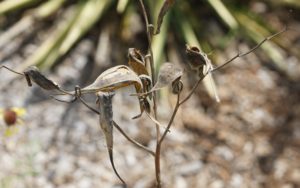
Which ornamentals will survive severe drought? It’s something I’ve asked myself often recently, because my yard has not received measurable rain in a month. With the heat and drought, most of my plants are under extreme stress.
I strive for relatively xeric gardens, but I’ve had to start watering because most of my plants have not had time to get well established. Watering by hand is pretty tedious, though, and it made me start wondering: what perennials could I let go safely, knowing that they might go dormant, but still come back in spring? And which annuals and perennials might reseed so freely that I could expect them to return in spring even though they might die prematurely in early summer?
The answer is surprisingly elusive. There is plenty of information available on drought-tolerant (xeric) plants. But that wasn’t exactly what I wanted to know. I have a yard full of drought-tolerant plants, but many are still struggling. I wanted to know which plants I didn’t have to water at all.
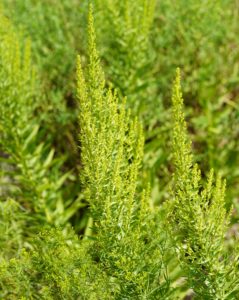
This goldenrod looks fine despite four weeks without any water.
Luckily for you (although not my poor plants), I have extensive experience in trying to keep plants healthy during long dry summers without regular irrigation. Sometimes I have failed, but, to my surprise, some plants that I’d given up for dead came back. So, I have a list that I know will come back reliably after even severe drought, with the caveat that they’ve had time to become established first. New plants generally die without supplemental watering, so be careful with anything planted recently (within the last 2-3 years).
So, here is my personal list of plants that may go dormant, come back from taproots, or reseed freely; plus a few that just ignore drought altogether.
These May Go Dormant
A thorough google search has not provided much information on the subject of perennials that safely go dormant in drought. I did find a simple explanation for what dormancy is and a few discussions about drought-dormancy in turf grass.
However, I know that plants with bulbs or corms usually come back after dormancy. If you think about it, this makes sense. Many of these plants flower in spring or early summer and then go dormant anyway. They store their energy in the bulb or corm so they have a sugar reserve in place. Tulips and daffodils are well-known ephemerals that do this. Daylilies, four o’clocks, cannas, bearded iris, peonies, crinum lilies, naked ladies, violets, and liatris are other plants that may go dormant during drought but will probably survive. Some will come back as soon as conditions improve (daylilies); others will wait until spring.
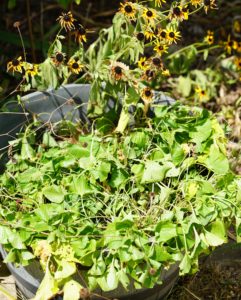
Believe it or not, there is woodland phlox in this container. It’s dormant now, but if experience holds true, it, and the violets, will come back fine in spring.
These Have Taproots
Some plants with established taproots will also come back. These plants may wither and appear to die in drought, but, if established, have an extensive root or root system that stores energy and moisture, enabling miraculous recoveries. Many prairie natives have deep roots, a fact which helps them survive droughts, and not just because they reach deep into the soil where moisture lingers. Plants that can come back from a tap root include orange butterfly weed, lead plant, ironweed, and false indigo (baptisia). I’ve had all of these come back after I thought they’d died in summer.
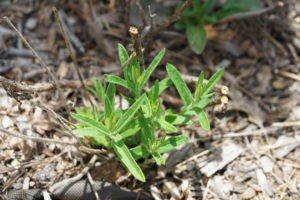
This orange butterflyweed, planted this spring, went dormant after blooming. The silly thing is putting out new foliage now, in the middle of the drought. But it should be just fine.
These Will Reseed
A few plants, including annuals, will reseed so freely I can trust them to come back year after year even if they die during a drought. Black-eyed Susans, many sunflowers, cow pen daisies, larkspur, zinnias, and cosmos are on this list. Some people have great luck with coneflowers, too, but I am not one of them.
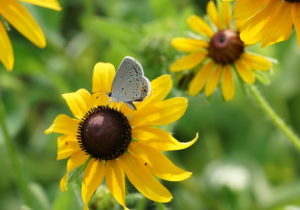
Black-eyed Susans are prolific; they’ll probably reseed even if they die during a drought.
These Ignore Drought
These plants will typically survive droughts without watering: autumn sage, pink evening primrose, Maximillian sunflowers, pink dianthus, lantana, goldenrods, pink muhly grass, Mexican hat, Russian sage, yarrow, certain asters, senna, catmint, red hot pokers, purple heart, wild bergamot (Monarda fistulosa), slender mountain mint, certain varieties of Agastache, yucca, and, of course, many succulents like sedum, ice plant, moss rose, and purslane.
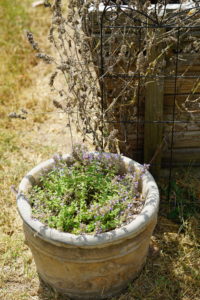
This catmint was planted this spring. It is merrily ignoring the fact it hasn’t been watered often. Note the agastache behind it. Surprisingly, it comes back in spring after doing this every summer. I don’t know if it is reseeding or going dormant.
Several flowering shrubs are extremely drought resistant, as well: rose of Sharon, lilac, crepe myrtle, and flowering quince. Established trees and shrubs are surprisingly drought-tolerant even if they aren’t labeled as being so.
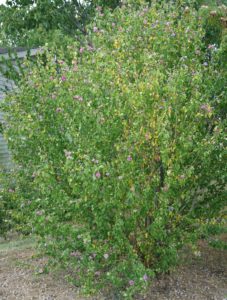
My rose of Sharon looks awful. But it will survive.
There are many more xeric and drought-tolerant plants, of course. These are just a few I know from personal experience. Also, stressing your plants to the point of dormancy may not be the best way to help them through droughts. I do it because I want a landscape that I don’t have to water at all, eventually. I don’t know that I’ll ever achieve that goal, if for no other reason than I can’t foresee a time when I’m not adding something to it, and new plants always need a little help. But, theoretically, I will have to water less and less. Others may have “inferno gardens” in spots without irrigation or beyond the reach of the hose. Hopefully, I’ve provided some ideas for those hard-to-water spots.
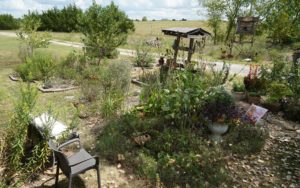
This is my front yard after a month of drought. It still has enough flowers to attract butterflies and pollinators, and I haven’t lost any plants yet. I have watered a few plants, but most have gone without supplemental water.
Meet Leslie Miller
Leslie Ann Miller shares 3.5 acres in rural Oklahoma with birds, butterflies and wide variety of animals. She is currently transforming her yard with plantings…
Leslie's Recent Posts
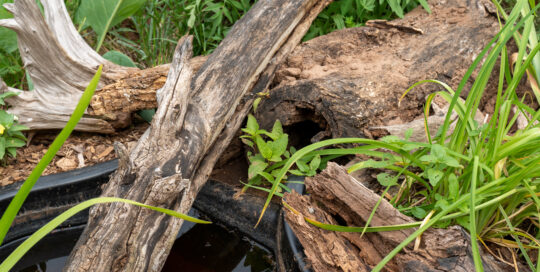
Creating microclimates and microhabitats to benefit wildlife






